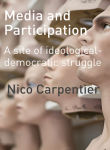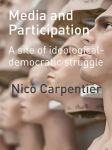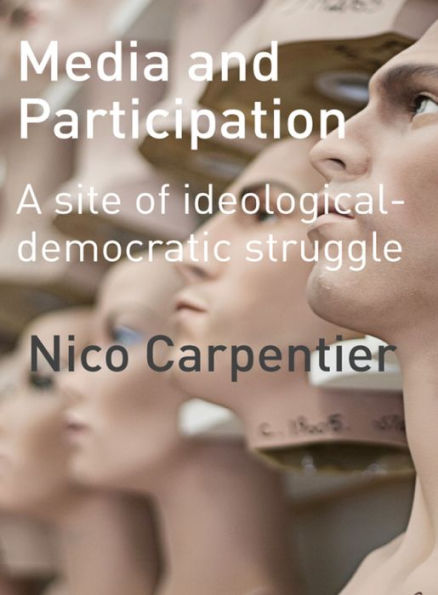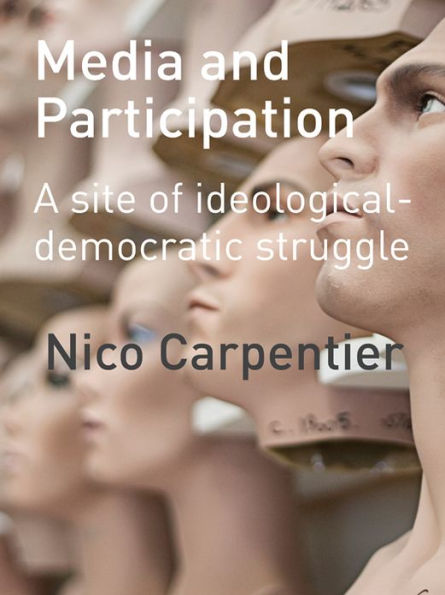Participation has become fashionable again, but at the same time it has always played a crucial role in our contemporary societies, and it has been omnipresent in a surprisingly large number of societal fields. In the case of the media sphere, the present-day media conjuncture is now considered to be the most participatory ever, but media participation has had a long and intense history. To deal with these paradoxes, this book looks at participation as a structurally unstable concept and as the object of a political-ideological struggle that makes it oscillate between minimalist and maximalist versions. This struggle is analysed in theoretical reflections in five fields (democracy, arts, development, spatial planning and media) and in eight different cases of media practice. These case studies also show participation’s close connection to power, identity, organization, technology and quality.
Participation has become fashionable again, but at the same time it has always played a crucial role in our contemporary societies, and it has been omnipresent in a surprisingly large number of societal fields. In the case of the media sphere, the present-day media conjuncture is now considered to be the most participatory ever, but media participation has had a long and intense history. To deal with these paradoxes, this book looks at participation as a structurally unstable concept and as the object of a political-ideological struggle that makes it oscillate between minimalist and maximalist versions. This struggle is analysed in theoretical reflections in five fields (democracy, arts, development, spatial planning and media) and in eight different cases of media practice. These case studies also show participation’s close connection to power, identity, organization, technology and quality.

Media and Participation: A Site of Ideological-Democratic Struggle
410
Media and Participation: A Site of Ideological-Democratic Struggle
410eBook
Available on Compatible NOOK devices, the free NOOK App and in My Digital Library.
Related collections and offers
Overview
Participation has become fashionable again, but at the same time it has always played a crucial role in our contemporary societies, and it has been omnipresent in a surprisingly large number of societal fields. In the case of the media sphere, the present-day media conjuncture is now considered to be the most participatory ever, but media participation has had a long and intense history. To deal with these paradoxes, this book looks at participation as a structurally unstable concept and as the object of a political-ideological struggle that makes it oscillate between minimalist and maximalist versions. This struggle is analysed in theoretical reflections in five fields (democracy, arts, development, spatial planning and media) and in eight different cases of media practice. These case studies also show participation’s close connection to power, identity, organization, technology and quality.

Product Details
| ISBN-13: | 9781841505244 |
|---|---|
| Publisher: | Intellect Books |
| Publication date: | 04/01/2011 |
| Sold by: | Barnes & Noble |
| Format: | eBook |
| Pages: | 410 |
| File size: | 2 MB |
About the Author
Nico Carpentier is Associate Professor at the Communication Studies Department of the Vrije Universiteit Brussel (VUB – Free University of Brussels) and Docent at Charles University in Prague. He is also an executive board member of the International Association for Media and Communication Research (IAMCR) and he was vice-president of the European Communication Research and Education Association (ECREA) from 2008 to 2012. His theoretical focus is on discourse theory; his research interests are situated in the relationship between media, journalism, politics and culture, especially towards social domains as war and conflict, ideology, participation and democracy. This has been translated into the following five topical areas: (1) Media, participation and democracy; (2) Media, death and war; (3) Journalism and identity; (4) Audience and reception; (5) Discourse theory.
Nico Carpentier is extraordinary professor at Charles University (Prague, Czech Republic); he also holds a part-time position at Vilnius Gediminas Technical University (Lithuania). Previously, he was treasurer (2005–12) and vice-president (2008–12) of the European Communication Research and Education Association (ECREA), and treasurer (2012–16) of the International Association for Media and Communication Research (IAMCR). Currently, he is IAMCR president (2020–24).
Contact: Institute of Communication Studies and Journalism, Faculty of Social Sciences, Charles University, Smetanovo nábřeží 6, 110 01 Prague, Czech Republic.
Read an Excerpt
Media and Participation
A site of ideological-democratic struggle
By Nico Carpentier
Intellect Ltd
Copyright © 2011 Intellect LtdAll rights reserved.
ISBN: 978-1-84150-524-4
CHAPTER 1
Defining Participation: An Interdisciplinary Overview
The concept of participation features in a surprising variety of frameworks, which have been transformed through an almost infinite number of materializations. This first chapter analyses the articulation of participation in five theoretical frameworks, without focusing too much (yet) on their actual materialization in participatory practices; however, I do not lose sight of the basic fact that theorizations are often grounded in reflections on specific and actual materializations. The five fields I scrutinize are democracy, spatial planning, development, arts and museums, and communication, all of which are rich in what they have to offer on participation. This chapter juxtaposes the different fields, with a series of discourse-theoretical techniques working in the background, to provide a detailed and interdisciplinary mapping of the ways that participation has been articulated in and across these fields. Together, these five fields are evidence of the social need for participation and the desire of people to exert control over their everyday lives, but also of the difficult relations people have with the ways that their participation is organized, structured and (thus) limited.
1. Democratic theory and participation
1.1 An introduction
Democracy, because of its concern with the inclusion of the people within political decision-making processes, is one of the key sites of the articulation of the concept of participation. The centrality of people's participation is described in Held's (1996: 1) definition of democracy as "a form of government in which, in contradiction to monarchies and aristocracies, the people rule. Democracy entails a political community in which there is some form of political equality among the people". Held's work provides an immediate and excellent overview of the complexity of the notion of democracy. In his Models of Democracy, Held (1996: 3) initiates the debate by referring to Lively's (1975: 30) list of ways to organize this form of political equality in practice. Lively distinguishes seven variations: (1) all should govern; (2) all should be involved in crucial decision-making; (3) rulers should be accountable to the ruled; (4) rulers should be accountable to the representatives of the ruled; (5) rulers should be chosen by the ruled; (6) rulers should be chosen by the representatives of the ruled and (7) rulers should act in the interest of the ruled. This list first highlights the strong emphasis in democratic theory on the difference between rulers and ruled, with the important consequence that the concept of participation is articulated exclusively in relation to the ruled, ignoring the rulers. The list can also be seen as an initial indication that democracy is not a stable concept with a fixed signification, but encompasses a multitude of meanings.
The meaning of the concept of democracy is complicated by three elements: the variety of democratic manifestations and variants; the distinction between formal democracy and democratic cultures and practices; and the distinction between the narrow-political system ('politics') and the broad-political dimensions of the social (the 'political'). One of the crucial dimensions structuring the different democratic models is the minimalist versus maximalist dimension, which underlies a number of key positions in the articulation of democracy.
One of these key positions is the always-present balance between representation and participation, which, for instance, provides structuring support for Held's (1996) typology of democratic models. As Held describes it, "Within the history of the clash of positions lies the struggle to determine whether democracy will mean some kind of popular power (a form of life in which citizens are engaged in self-government and self-regulation) or an aid to decision-making (a means to legitimate the decisions of those voted into power)" (Held, 1996: 3 – emphasis in original). The notion of representation refers here to political representation, Vertretung, or speaking-for, in contrast to the other main meaning of representation, Darstellung, or standing-for (Spivak, 1990: 108). Political representation is grounded in the formal delegation of power, where specific actors are authorized on behalf of others "to sign on his behalf, to act on his behalf, to speak on his behalf" and where these actors receive "the power of a proxy" (Bourdieu, 1991: 203). Obviously, one of the basic democratic instruments for the formal delegation of power is elections, where, through the organization of a popular vote, political actors are legitimized to gain (at least partial) control over well-defined parts of the state's resources and decision-making structures. This control is not total, but structured through institutional, legal (often constitutional) and cultural logics.
On the other side of the democratic balance is the notion of political participation, which refers to the involvement of the citizenry within (institutionalized) politics. As Marshall (1992: 10–11) explains in his discussion of political citizen rights, this not only includes the right to elect, but also the right to stand for election: "By the political element [of citizenship] I mean the right to participate in the exercise of political power, as a member of a body invested with political power or as an elector of such a body". Again, these forms of political participation are not total, but structured through institutional, legal and cultural logics (see Dahlgren, 2009). One important example is the limits imposed by the concept of citizenship itself, which is not only a democracy-facilitating concept, but also has an exclusionary component.
Different democratic models (of democratic theory and practice) attribute different balances between these concepts of representation and participation. When the political is defined, following Schumpeter (1976), for instance, as the privilege of specific competing elites, thus reducing the political role of the citizenry to participation in the election process, the balance shifts towards representation and the delegation of power. This is what we can consider the first characteristic of the minimalist version of democratic participation. In this model, the societal decision-making remains centralized and participation remains limited (in space and time). In contrast, in other democratic models (e.g., participatory or radical democracy – see below), participation plays a more substantial and continuous role and does not remain restricted to the 'mere' election of representatives. These democratic models with more decentralized societal decision-making and a stronger role of participation (in relation to representation) are considered here to be maximalist forms of democratic participation.
Figure 1 shows that the archetypical minimalist–maximalist dimension is characterized not only by the balance between representation and participation, but on the distinction that Thomas (1994) makes between micro- and macro-participation. While macro-participation relates to participation in the entire polis, country or political imagined community, micro-participation refers to the spheres of school, family, workplace, church and community. More minimalist models tend to focus more exclusively on macro-participation, since the political role of citizens is limited to the election of political representatives at the macro-level. A classic definition of political participation by Verba and Nie (1987: 2) states that political participation is "those activities by private citizens that are more or less directly aimed at influencing the selection of governmental personnel and/or the actions they take", which situates political participation within the field of macro-participation (see also Milbrath, 1965; Milbrath and Goel, 1977). Brady (1997: 737) uses a slightly broader definition of political participation as "any activity of ordinary citizens with the aim of influencing the political outcomes", but on the next page adds that these participatory efforts are "directed at some government policy or activity" (Brady, 1997: 738). More traditional public sphere models tend also to focus on macro-communicative processes, in the establishment of 'the' public opinion. This is a viewpoint echoed in Habermas's (1974: 49) old definition of the public sphere: "By the 'public sphere' we mean first of all a realm of our social life in which something approaching public opinion can be formed. Access is guaranteed to all citizens". In contrast, models of maximalist democratic participation tend to combine (attention for) the different spheres of the social, without ignoring participatory practices within the field of institutionalized politics, at a variety of levels, including local politics, interest group politics and activist politics. But these strong (er) forms of citizen involvement are not restricted to institutionalized politics; participatory practices can also be embedded within the structures of everyday life (which can be located in civil society, businesses or families). For instance, in The Transformation of Intimacy, Giddens formulates a warm plea for the "radical democratisation of the personal" (Giddens, 1992: 182) on the basis of the argument that a symmetry exists between "the democratising of personal life and democratic possibilities in the global political order at the most extensive level" (Giddens, 1992: 195–196). Pateman (1970) also emphasizes the role of (macro-participation in) representative democracies, but combines this with attention for participatory processes in other societal spheres, such as the workplace:
Apart from its importance as an educative device, participation in the workplace – a political system – can be regarded as political participation in its own right. Thus industry and other spheres provide alternative areas where the individual can participate in decision making in matters of which he [or she] has first hand, everyday experience. (Pateman, 1970: 35)
A third characteristic of the minimalist–maximalist dimension, which tries to capture the process of broadening the locus of participation (and which is closely related to the role played by micro- and macro-participation), is based on the distinction between politics and the political. Here, minimalist democratic participation is focused more on institutionalized politics, which renders it mono-sited. In contrast, maximalist democratic participation is embedded in the political, which makes it multi-sited. Mouffe, for instance, describes the distinction between politics and the political as follows:
By 'the political,' I refer to the dimension of antagonism that is inherent in human relations, antagonism that can take many forms and emerge in different types of social relations. 'Politics' on the other side, indicates the ensemble of practices, discourses and institutions that seek to establish a certain order and organize human coexistence in conditions that are always potentially conflictual because they are affected by the dimension of 'the political'. (Mouffe, 2000: 101, see also Mouffe, 2005: 8)
In other words, according to Mouffe (1997: 3), the political "cannot be restricted to a certain type of institution, or envisaged as constituting a specific sphere or level of society. It must be conceived as a dimension that is inherent to every human society and that determines our very ontological condition". The phrasing of Mouffe's distinction confusingly diverges from a series of (structurally similar) arguments that maintain the word politics, while broadening its meaning (see, in this context, for instance Beck's (1997) concept of sub-politics, Giddens's (1991) concept of life politics and cultural studies' use of the politics concept (see e.g. Hall, 1997a: 257)). Despite these differences we find in these intellectual projects the tendency to broaden the concept of politics (and the political) beyond the confinements of institutionalized politics. This, in turn, allows me to further characterize minimalist democratic participation as mainly concerned with the field of (institutionalized) politics, while maximalist democratic participation relates to the political.
The debate over the locus of participation and decision-making brings us to the fourth characteristic of the minimalist–maximalist dimension, namely the difference between unidirectional versus multidirectional participation. In minimalist forms of democratic participation, participation is aimed at one specific field – that of institutionalized politics. But in the less extreme versions of minimalist democratic participation, which include participatory practices in other fields of the social, the unidirectional objective of participation is also to influence institutionalized politics. One already-mentioned example is Verba and Nie's (1987: 2) definition, where participatory practices are aimed at "influencing the selection of governmental personnel and/or the actions they take". Similarly, a number of theoretical models that deal with the public sphere and public opinion, a societal field which is still structurally different from institutionalized politics, tend to focus on the capacity of the public sphere(s) and public opinion(s) to impact on institutionalized politics. For instance, Burke (discussed in Splichal, 2001: 22–23) emphasizes the importance of public opinion, and the need for government to be ruled by public opinion. Slightly more recent communication models, such as the agenda-setting model, focus very strongly on the relationships between public (and media) agendas and the agenda of institutionalized politics (McCombs and Shaw, 1972).
Maximalist democratic participation tends to see participatory processes as multidirectional, without privileging the relationship of the sites of participation with institutionalized politics. Although the connections with institutionalized politics are not severed, the broad definition of the political, combined with the inclusion of micro-participation in maximalist democratic participation, allows for the validation of participatory practices within the field in which they take place, and through their interconnection with other fields. For instance, participation within the field of museums (as defended by some of the proponents of new museology – see e.g. van Mensch (2005) on the third shift of museology) is considered relevant in itself, as it provides visitors and stakeholders with opportunities to influence these symbolic environments. Moreover, the interconnectedness of the participatory practices is deemed important for strengthening a participatory culture within the social. From this perspective, then, the participation of museum stakeholders is considered relevant since it contributes (as all participatory practices in specific societal fields) to the democratization of democracy (Giddens, 2002: 93).
Another characteristic of the minimalist–maximalist dimension is the attributed homogeneity or heterogeneity of the actors involved in the decision-making processes. Especially in cases where these decision-making processes are aimed at reaching decisions and establishing outcomes (which does not always apply), there is an attempt to reach communality and collectivity through a procedure that allows for negotiation among a diversity of positions. An obvious example is election procedures, which aim to achieve a specific outcome (selecting a limited number of political representatives) through a specific procedure (based on 'universal' suffrage), which allows for negotiation between the diversity of individual preferences. The negotiation procedure always carries a specific cost, which, in the case of for elections, for instance, might be the extremely limited impact of the individual's action on the election outcome (Aldrich, 1993). Nevertheless, the procedure allows the diversity of positions to be translated into a decision that (often) is accepted as legitimate. But this translation remains a tension, which may be resolvable. One strategy is to homogenize the actor(s) involved in the decision-making process. The concepts that provide discursive support for this homogenization strategy are 'popular will' and 'public opinion' (especially when public opinion is behaviouralistically defined "as opinion expressed by the public" – see Splichal (2001: 41) for a discussion and critique). In these cases, the participatory procedures are seen to be resulting in the expression of a collective and homogeneous public will ('the people have spoken'). In other cases, specific actors (such as the mainstream media) are seen as legitimate channels for the expression of 'the' public opinion, or the people's vanguard, again homogenizing the diversity of positions. These processes of homogenization and hegemonization are strengthened by the ignorance about the positions and voices of the minorities (in number or substance) who took another position. Another (related) strategy consists of recognizing the existence of diversity beforehand, but the procedure is seen as suspending or halting the existence of diversity. This type of strategy could be used after a majority vote, but the Habermasian Diskurs – where the "forceless force of the better argument" (Habermas, 1999: 450) rules – is also based on a logic where diversity ends after the procedure. In addition, the strategy of the compromise suspends diversity, albeit to a lesser degree, as different positions are articulated and remain visible as part of the outcome. But in the case of a compromise, the outcome continues to suspend diversity because positions become integrated into the outcome of the negotiation. A third strategy to deal with the tension between position diversity and outcome singularity defines the procedure itself as an intervention that only temporally fixes a singularity, which is considered as always particular and contestable. Here, an outcome is still achieved, but the opportunity to reconsider and to rebalance the different positions is enshrined in the decision itself. One other variation here is so-called non-decisions, where the position diversity makes decision-making impossible or undesirable. Arguably, the more minimalist forms of democratic participation tend to focus on the strategies of homogenization, because of the large-scale decision-making processes (or in other words, the focus on macro-participation), and their significance in generating legitimacy for institutionalized politics, the state and the nation (which is related to the unidirectional focus of minimalist democratic participation). In contrast, maximalist democratic participation is characterized more by heterogeneity, which is triggered by the diversity of decision-making loci in the political field, generated through the combination of micro- and macro-participation, and the multidirectional nature of participatory practices.
(Continues...)
Excerpted from Media and Participation by Nico Carpentier. Copyright © 2011 Intellect Ltd. Excerpted by permission of Intellect Ltd.
All rights reserved. No part of this excerpt may be reproduced or reprinted without permission in writing from the publisher.
Excerpts are provided by Dial-A-Book Inc. solely for the personal use of visitors to this web site.



